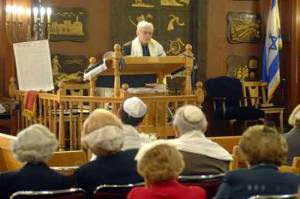The Opening Prayer (Collect) is prayed at Mass and then the People sit in order to hear the Word of God in the proclamation of the Scriptures.
God Speaks to Us!
The most basic meaning of this Liturgy of the Word is that God is speaking to us!
This statement that "God is speaking to us" is absolutely amazing and yet we take it for granted or we don’t really appreciate the claim. Why should the One who is altogether greater than us speak to us at all? There is nothing that says that God has to communicate with us or reveal anything of himself to us.
God, however, seems to have had a "communication problem" with us! He speaks but do we listen? How can he get through to us? God’s solution to this is found in Hebrews 1:1-2a:
"In times past, God spoke in partial and various ways to our ancestors through the prophets; in these last days, he spoke to us through the Son..."
The Son of God became flesh in Christ Jesus and he revealed God’s Word to us, because he is that Word: all that God wants to say to us:
"And the Word became flesh and made his dwelling among us,
and we saw his glory, the glory as of the Father’s only Son, full of grace and truth.
"No one has ever seen God. The only Son, God, who is at the Father’s side,
has revealed him." (John 1:14, 18)
The Bible as God’s Word
That which we call the Bible or the Scriptures are inspired by God and they show us who God is as revealed in and by Christ Jesus. In the Liturgy of the Word in the Mass, Christ speaks to us through the Scriptures proclaimed:
"When the Sacred Scriptures are read in the Church, God himself speaks to his people, and Christ, present in his word, proclaims the Gospel" (General Instruction on the Roman Missal, # 29).
|
How would it be a different experience if I believed that God is speaking to me in the Scriptures proclaimed at Mass?
|
The Roots of the Liturgy of the Word
Jesus and the early disciples were first Jewish. Jews gathered in the "Meeting Place," i.e. the Synagogue, to hear the Word of God from what we today call the "Old Testament," to pray, especially with the Psalms, and to make Intercession to God. This is very much the precedent for the Church’s Liturgy of the Word.
We know from early church documents that the Church also proclaimed Old and New Testament Readings, sang Psalms, and read from the Gospel. At first this was very fluid and eventually became more and more established in its liturgical pattern.
At first the Mass was in the language that most people could understand: first Greek and later in Latin in the Western part of the Roman Empire. But after the Fall of the Roman Empire in the West, the languages of the various places in Europe developed distinct differences, but Latin was retained for the Mass. Even the proclamation of the Scriptures was in Latin and only very educated persons could understand it. The stories of Scripture became taught more and more visually through paintings and stain glass.
The Reform of the Second Vatican Council
Starting in the 1960's, the Second Vatican Council called for more Scripture to be read and preached at Mass and began to permit this in the vernacular languages of the People. The range of what consisted of the Scripture Readings at Mass broadened to this pattern on Sunday:
The Lectionary, which contains the Scripture Readings read at Mass for the various Sundays and Feast Days of the year was expanded so that over a three-year period the Gospels of Matthew, Mark and Luke would be proclaimed (formerly it was mostly Matthew), selections of John’s Gospel, as well as Old and New Testament Readings.
The Readings also have a particular relationship to one another depending on the Liturgical Season. For example, in the Advent, Christmas, Lent and Easter Seasons all three Scripture Readings–the Old & New Testaments, and Gospel–are all related to the themes of that Season.
The other Sundays of the Year are known as Ordinary time. That doesn’t mean they are not special; it means they are "ordered." So, for example, the Gospel begins at the beginning and goes each Sunday, chapter by chapter, in order, with some editing. The Second Reading from the New Testament is the same way.
In Ordinary time, the Old Testament Reading is not read in order. Rather, it somehow corresponds to the Gospel and in some way prepares for it and interprets it. The Old Testament Reading in Ordinary Time and the Gospel are always related to each other. The New Testament Readings, however, are not related to the Gospel and they run on their own parallel track, so to speak.
In this way, the People of God, over three years continuously, are given a rich fare of Scripture in the Sunday Mass.
Next Week: The Liturgy of the Word: How it is Proclaimed



